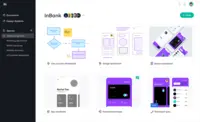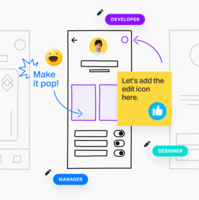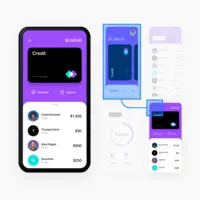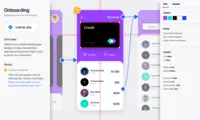Overview
What is InVision?
InVision is a collaborative design and prototyping platform with features such as freehand drafting mode and interactive mockups, collaboration, idea management, user testing, and integration with Slack and other collaboration tools. According to the vendor, 1 million designers are using…
great tool for interactive prototypes
Great for sharing and collaborating across teams
InVision: A Great Tool for PMs to Share Designs with Teams and Customers
Great for DSM and simple prototyping
It's fine, I wish my company would switch to Figma
Invision on the fly
Headed for Extinction
InVision aids in fast virtual collaboration
InVision--Collaborative Prototyping Staple
Rapid Prototyping and Extensive Collaboration
InVision, platform that once WOWed is now ehh
Why InVision gives you a clear vision
Great for design collaboration, inventory and sharing of assets
InVision was the perfect fit for our agency. Simple, easy to use and effective.
InVision: Create beautiful designs for great products
Awards
Products that are considered exceptional by their customers based on a variety of criteria win TrustRadius awards. Learn more about the types of TrustRadius awards to make the best purchase decision. More about TrustRadius Awards
Pricing
Free
$0
Pro
$7.75
Enterprise
Contact Sales
Entry-level set up fee?
- No setup fee
Offerings
- Free Trial
- Free/Freemium Version
- Premium Consulting/Integration Services
Product Demos
InVision Studio Demo + Drinks: Berlin
InVision Studio Demo + Drinks: Boston
inVision DVA & GST Demo
Vid Invision Demo Video
Invision and Live - Amiga CG Demo from a long time ago
Invision Studios 2020 Demo Reel
Product Details
- About
- Competitors
- Tech Details
- FAQs
What is InVision?
InVision Screenshots
InVision Video
InVision Technical Details
| Deployment Types | Software as a Service (SaaS), Cloud, or Web-Based |
|---|---|
| Operating Systems | Unspecified |
| Mobile Application | No |
Frequently Asked Questions
Comparisons
Compare with
Reviews and Ratings
(216)Community Insights
- Business Problems Solved
- Recommendations
InVision has been widely used by design teams to streamline the website design process and gather valuable feedback from clients. By providing tools for diagramming ideas, drawing wireframes, and creating prototypes, InVision has supported the translation of design discoveries into actual flows. Designers have found it beneficial for sharing initial mockups with clients and prototype dynamic designs with clickable interactive prototypes. This feature allows for a more in-depth feel of the design and facilitates collaboration and iterative improvements.
Additionally, InVision has played a crucial role in filling communication gaps and promoting collaboration between product, design, and engineering teams, as well as key stakeholders. It simplifies the design process for websites and digital marketing materials by allowing for easy client review and code extraction during development phases. The software's accessibility and project management features make it particularly useful for designers, UI/UX specialists, project managers, and product owners. Furthermore, InVision has been recommended by senior designers for its ability to upload designed interfaces and provide notes, making it easier for teams to understand the design intent. Overall, InVision has proven to be an invaluable tool in enhancing collaboration, facilitating handoff, and improving the overall efficiency of the design process.
Users highly recommend starting with the free version of InVision to thoroughly evaluate the product and its features. They believe it is important to invest time in training for InVision to fully benefit from its functionality. Comparing InVision with other products is also recommended to determine which tool best fits the user's needs. Lastly, if one is looking for a platform that truly showcases their project, users suggest trying another prototyping tool that better suits their requirements and preferences.
Attribute Ratings
Reviews
(1-25 of 28)great tool for interactive prototypes
- prototyping
- convey styling for developers based on design
- team collaboration
- assets sharing
- design system
- inspect can be improved upon
- integrations with other software like notion
- version control
Great for sharing and collaborating across teams
- clickable designs
- interactive designs
- mockups
- better design kit
- easier to use downlod for offline use
- Features to enable clickable prototypes
- Organization of wireframes to map out user flows
- Easily shareable assets
- For non-primary users, navigation can be difficult.
- Embedding of assets into other software is a challenge.
- When clicking through a flow, it would be nice to easily navigate to other screens without backtracking to the main menu.
Great for DSM and simple prototyping
Invision on the fly
- Provides quick tools for wireframe drawing
- tools for flow mapping/drawing
- Easy connection with third party applications, via links or direct connections
- would be nice to have commands for quick access to shapes from the keyboard
- Quicker integrations with Notion and lucid chart to have a slick experience
- The auto organize option should have multiple frame selection, sometimes is not the arranged expected for the wireframe
Headed for Extinction
- Real-time collaboration
- Archival design artifacts
- Low-friction access
- Clarity in user access/billing
- Branching/versioning
- Prototyping
InVision, platform that once WOWed is now ehh
- Upload to other 3rd party platforms such as Zeplin.
- Easy to use design interface.
- Lots of 3rd party plugins to simplify you life, Unsplash for stock photos for example.
- Limited in platforms it can upload to.
- 3rd party plugins don't often get updated and then break/don't function.
- Slow to develop some features, example animation for showing user experiences.
- Can be glitchy/buggy and updates sometimes makes things worse.
- Simple and intuitive interface, very easy to use and share.
- Great for collaboration with multiple users and stakeholders.
- A very professional and manageable way to house multiple assets, across clients and projects.
- Housing video files doesn't allow for easy preview or playing.
- Navigating around a large freehand board can be cumbersome and difficult to find your way to specific areas of interest without some nuancing.
- Easy to Use
- Commenting within Creative
- Clean user interface
- Good resources
- Notifications
InVision: Create beautiful designs for great products
- Allows seamless collaboration within a team on design.
- Helps us build clickable prototypes of our designs.
- Makes envisioning user experiences simple and uncomplicated.
- The web application is quite heavy and tends to lag from time to time.
- Same with the mobile app. It's not the quickest and easiest experience.
- Navigating through several designs can be difficult and confusing at times.
Great software for non-technical designers
- Clickable prototypes with multiple screens.
- Easy upload, due to the integration with software like Sketch.
- Easy-to-animate prototypes, with highly customizable options.
- Easy to access basic CSS code from graphic elements, making it easy to communicate to developers.
- Better integration between their different products. I don't know how to distinguish them based on the names.
- Better integration with Microsoft Teams (they have Freehand, but that's it). Option to share a prototype directly on teams.
- Options for testing InVision better. Currently, the limit is 1 prototype per free account.
InVision: Solid, But Falling Behind
- InVision is an easy-to-use tool for quickly putting together and editing prototypes in order to test and iterate upon user workflows.
- InVision's interface is modern and clear, making the user experience very pleasant and straightforward.
- InVision’s commenting and tracking features make it incredibly easy to communicate about specific parts of designs with stakeholders, as well as to follow those conversations. All of the feedback can be captured in one place, which is really helpful in revising designs.
- Designs can be very slow to load on mobile devices, particularly when they include many screens.
- There isn’t an offline version of the full app, which feels less-than-ideal for many of our teammates who live in areas with more spotty internet.
- There are limited functionalities to portray animations and transitions. This hasn’t been a huge issue, but it makes the app feel a little out of date, considering the range of such functionalities in other apps.
Great collaboration, interactive prototyping tool
- Very easy to export Sketch files (where prototypes are actually created) into Invision and preserve the interactivity.
- Additional interactivity can be added in InVision. Like scrolling with locked footer.
- Clients, designer and developers can collaborate - leave notes and respond to notes made by others.
- InVision's biggest problem for me right now is that if the change I make in Sketch is minor - it does not get picked up when I update my prototype in InVision. So I have to add large bright noticeable objects - then update the prototype then remove those objects and update the prototype again. It is a very time-consuming work around.
- Simple interface and easy to work with.
- Easy to collaborate
- Versioning is a key feature.
- Drag and drop feature speeds up things.
- No responsive design output.
- Initial loading should be better, it's slow.
- Nothing much.
Excellent design sharing and feedbacking tool
- Easily sharing designs and mockups.
- Creating folders and separate projects for easy handling of multiple projects.
- Great interface and ease of use.
- Lack of dynamic transitions between screens (ie. "mocked buttons").
Prototyping With InVision
- InVision is great for putting together prototypes because it's fast and simple.
- InVision is great for giving specs to your developers that they can inspect because it gives them the information they need to build it.
- Large InVision prototypes can often be slow on mobile phones because they have to download so many screens.
- InVision prototypes are pretty limited in terms of functionality.
- InVision works well with Sketch for the syncing of comps with a few clicks. This saves a lot of time in having to export JPGs and manually upload to InVision projects.
- InVision's commenting system makes it very easy for stakeholders to comment with markers directly on objects related to their comment. By tagging users in the comment, the users then get an email with a small screen capture of the doc and the commenter's comment. This makes it really simple for discussions to be tracked.
- It's a simple thing, but the ability to use the keyboard arrows to navigate back and forth through page views in InVision is very handy when presenting.
- The technology running InVision doesn't allow you to be signed in and open multiple documents at once. If you're in a project and want to present 2 different pages in the project, opening them in different browser tabs ultimate causes the InVision interface to crash, etc.
- It might have been thought of as a benefit, but I find that the ability to rename a screen once uploaded to InVision is confusing. Creators will have a naming convention for their files, and changing a files name in InVision for display makes it challenging to find the creator's original file by the name they used.
- Sharing a document with others not part of your organization is a clunky experience requiring the creation of a shareable link. There are a few options, and it's not always clear to people how they should generate the share. And then it's not clear to the person being shared with how to interact with InVision.
InVision allows for a simple prototype creation, but I find it easier and more robust using other tools. The InVision features are limited for prototype work, but it excels in sharing docs for feedback.
Invision saves us a lot of time and hassle implementing designs!
- The ability to leave comments on specific parts of the screen to add details or feedback for the developers. This removes the pain of trying to explain which screen/part of the screen you're referring to.
- InVision makes it extremely easy to create a clickable prototype and test the flow of your software.
- The design and user experience of InVision makes it very pleasant and extremely easy to use.
- InVision doesn't integrate with Illustrator to automatically upload new updates to designs. You have to go back in and re-upload the file which means also changing the flow of the clickable hot spots. But it does have that capability for Sketch and Photoshop.
- Because it's integrating with other platforms, it isn't as seamless of an experience as Adobe XD is at building and may be difficult to compete with Adobe over the long term because they have such a stronghold in the creative space.
- Other than that it has worked very well for us!
InVision - prototype, communicate, prototype, communicate, develop
- The "Inspect" feature is terrific. The designer doesn't need to come up with css mapping guide. It's automatic!
- Commenting on top of the assets is super easy and looks good.
- Working on prototypes saves a lot of development time.
- You need to upload complete assets as a page. You can't drag and drop elements to create screens.
- InVision is focused on designers. That's good, but some focus on non designers (developers, product) would be nice.
If your product does a lot of work prior to the designer coming in Proto.io would be a better solution.
InVision is great for communications so it's great for big teams. Even more when working on different times and locations. Products that don't have many pages and interactions don't have much to benefit for InVision.
- A physical print out
- A PDF sent over email
Using Invision allows us to have more control over the client's viewing experience. It allows us to present our digital designs on a digital medium.
- Comments: Invision allows your clients to make comments on a design template. Gone are the days of trying to decipher a client's red-sharpie markup on a printed design. Invision comments are neat and organized, and closely tied to on-page elements. Read comments individually or answer several at once in the "comments" pane. Clients receive responses to their comments via email.
- Invision Inspect: Invision Inspect is amazing. If you are synching designs to Invision using the Craft or Sketch integrations (which I recommend), all of the CSS and HTML code will be auto-generated by Invision Inspect. Developers can use the Inspect pane to accelerate development
- Hotspots: With invision, you can create "hotspots" on your design, allowing you to create a very realistic-feeling experience for your clients. Select a button as a hotspot to link it to another page of your design. You can also assign hot spots to anchor link to another position on the existing page. The end result is immersive and allows the client to better understand the relationship between pages of your design. It offers functionality to an otherwise static thing.
- Mobile: Invision displays mobile mocks inside of a mobile phone template. This adds to the realism and creates a more professional, polished look. You can also lock the header nav or footer on mobile devices to simulate "sticky" elements, which again, really adds a realistic quality.
- Integrations: Automatically synch your designs directly from Sketch to Invision using the Craft plugin. This is fantastic because it allows your clients to view changes, practically in real-time, without requiring you to login to multiple platforms to make updates
- Drains resources: Invision is HEAVY. I can't pull up more than one Invision tab on my laptop or else it will start to crawl. It drains my computer's resources.
- Ordering screens: While the auto-synch from Craft and/or Sketch is amazing, it's not as good as it could be. I am working on a 200+ screen project with a client. Every time my designer synchs using the Craft plugin, I need to search through Invision to see where it dropped the new or updated screens. It is seemingly random, and very hard to keep track of. I need to audit the organization of screens weekly to make sure everything is where it should be. This is extremely hard to do on a small laptop with a touchpad, since it relies on a drag-and-drop interface, but it's no problem with a mouse.
- Email overload: The default notification settings will send you an email each time someone leaves a comment on a mock. This is a nightmare for my zen at work - be sure to change the setting to receive a daily or weekly digest instead
- Responsiveness: Invision hasn't really cracked the secret of displaying responsive designs through a static medium. We typically create desktop and mobile mocks for our website projects. You can't load mocks with different canvas sizes to the same project - they must be uploaded to two separate projects. This is a pain to manage. Ideally, I'd love to be able to resize my screen and show my client how the design "jumps" from desktop to mobile at a particular breakpoint. This is not possible.
- Intuitiveness: There are some parts of Invision that are incredibly intuitive, and some that aren't. Maybe this is just me, but it took me a year to realizze you could shift+click to select multiple screens for the purposes of re-ordering. There are a few things like that that just didn't feel "natural" to me.
My vision for InVision
- You can add unlimited commands and notes for just one interface.
- Seamless integration with Sketch.
- Automatically generate HTML/CSS code for developers.
- Easy to show animation and prototypes without coding.
- Not valuable for complex prototypes.
- Lack of responsive features.
- You have to re-upload the whole interface if you make a minor change to the design.
InVision - a game-changer for distributed teams
- Ease of prototype building. It is great to be able to quickly show stakeholders how a series of screens function together rather than relying solely on flat images.
- Shared links and comments. Invision allows team members and stakeholders to collaborate no matter the location or time zone.
- Freehand sketching is a powerful tool that allows real-time collaboration across multiple locations.
- Invision is great for linear prototyping. When it comes to more complicated needs, Invision becomes less valuable.
- Invision's pricing model can become expensive quickly - beware of having too many reviewers.
Prototyping Made Easy
- Version control is very simple to use and well laid out, and you don't need multiple files.
- You can show your clients how their product will look on a variety of different devices, such as mobile.
- Besides just moving between pages, there are options for things like a fixed navbar and linking to hotspots within the current page.
- You can automatically upload screens from both Photoshop and Sketch.
- There could be a few more options for interactions, such as image carousels, link/image hovering, and page transitions.
- It would be nice to be able to upload from Illustrator, or other Adobe software.
My experience with Invision
- InVision integrates with a lot of tools like Sketch where you can just drop the file in and have screens to work with.
- InVision has lots of customization so you can set up flows for different devices.
- It's relatively easy to use.
- The hotspot templates are a bit hit or miss - sometimes the spot will be linked across all my pages while other times it will appear in bizarre areas of the page - I tend to have to manually make custom hotspots instead.
- Some of the advanced prototyping features are a bit overwhelming to use, like adding forms, it would be nice to have some tutorials on those.
Prototyping?? (Nothing is better than InVision)
- I love the comment option in InVision. It's an awesome thing for a freelancer developer. I just make the prototype, send it to the client, mostly he loves it. If there is anything he wants me to change, he puts a comment on that particular area on the page. So you have 30 pages, the client puts the comment on changes required area and you change them accordingly. It might seem basic but it's really useful.
- The History Mode is an awesome thing in InVision. It's like git to me, it keeps a track of all the previous changes I made and all the comments which were added. It helps me check if I have fulfilled all the comments and changes asked by the client.
- And Live Share is the best thing - it helps the client get the exact idea of what the website is gonna look like once it is completed.
- It's not free. I mean you can only work on one project with a free account and of course you don't just have one project to work on.
- It takes some time to get a hang of the tool. I mean you really need to understand the tool; it took me like 2-3 hours to understand most of the basic features, but keep experimenting, that's life.
















